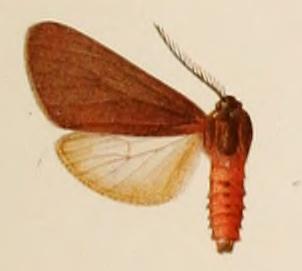
The Luna moth is a Nearctic moth in the family Saturniidae, subfamily Saturniinae, a group commonly known as giant silk moths. It has lime-green colored wings and a white body. The larvae (caterpillars) are also green. Typically, it has a wingspan of roughly 114 mm (4.5 in), but can exceed 178 mm (7.0 in), making it one of the larger moths in North America. Across Canada, it has one generation per year, with the winged adults appearing in late May or early June, whereas farther south it will have two or even three generations per year, the first appearance as early as March in southern parts of the United States.

The Arctiinae are a large and diverse subfamily of moths, with around 11,000 species found all over the world, including 6,000 neotropical species. This group includes the groups commonly known as tiger moths, which usually have bright colours, footmen, which are usually much drabber, lichen moths, and wasp moths. Many species have "hairy" caterpillars that are popularly known as woolly bears or woolly worms. The scientific name of this subfamily refers to this hairiness. Some species within the Arctiinae have the word tussock in their common name due to people misidentifying them as members of the Lymantriinae based on the characteristics of the larvae.

The cinnabar moth is a brightly coloured arctiid moth found as a native species in Europe and western and central Asia. It has been introduced into New Zealand, Australia and North America to control ragwort, on which its larvae feed. The moth is named after the red mineral cinnabar because of the red patches on its predominantly black wings. The species was first described by Carl Linnaeus in his 1758 10th edition of Systema Naturae. Cinnabar moths are about 20 mm (0.79 in) long and have a wingspan of 32–42 mm (1.3–1.7 in).

Phthorimaea operculella, also known as the potato tuber moth or tobacco splitworm, is a moth of the family Gelechiidae. It is an oligophagous insect that feeds on the plant family Solanaceae and is especially known for being a major pest of potato crops. Currently farmers utilize insecticides, parasites, and sprinkler irrigation in order to prevent P. operculella from infesting their croplands.

Euchaetes egle, the milkweed tiger moth or milkweed tussock moth, is a moth in the family Erebidae and the tribe Arctiini, the tiger moths. The species was first described by Dru Drury in 1773. It is a common mid- through late-summer feeder on milkweeds and dogbane. Like most species in this family, it has chemical defenses it acquires from its host plants, in this case, cardiac glycosides. These are retained in adults and deter bats, and presumably other predators, from feeding on them. Only very high cardiac glycoside concentrations deterred bats, however. Adults indicate their unpalatability with clicks from their tymbal organs.

Euchaetes is a genus of moths in the family Erebidae. It was described by Thaddeus William Harris in 1841.

Euchaetes fusca is a moth of the family Erebidae. It is found from the south-western United States to Costa Rica.
Euchaetes albicosta is a moth of the family Erebidae. It was described by Francis Walker in 1855. It is found from Texas, south to Mexico and Nicaragua.
Euchaetes antica is a moth of the family Erebidae. It was described by Francis Walker in 1856. It is found from Arizona and New Mexico in the US, south to Mexico, Nicaragua, Honduras and Guatemala.
Euchaetes bolteri is a moth of the family Erebidae. It was described by Richard Harper Stretch in 1885. It is found from the US states of Texas and New Mexico to Mexico and Costa Rica.
Euchaetes castalla is a moth of the family Erebidae. It was described by William Barnes and James Halliday McDunnough in 1910. It is found in the US state of Arizona.
Euchaetes cressida is a moth of the family Erebidae. It was described by Harrison Gray Dyar Jr. in 1913. It is found in the US state of Texas and Mexico.
Euchaetes elegans, the elegant pygarctia, is a moth of the family Erebidae. It was described by Richard Harper Stretch in 1874. It is found in the US states of California, Arizona, New Mexico, Nevada and Texas, and in Mexico, Guatemala, Panama and Colombia.
Euchaetes expressa is a moth of the family Erebidae. It was described by Henry Edwards in 1884. It is found in Mexico and Costa Rica.
Euchaetes gigantea is a moth of the family Erebidae. It was described by William Barnes and James Halliday McDunnough in 1910. It is found in the US states of Arizona, New Mexico and Oklahoma.
Euchaetes perlevis is a moth of the family Erebidae. It was described by Augustus Radcliffe Grote in 1882. It is found in the US states of Arizona, New Mexico and Texas.
Euchaetes polingi is a moth of the family Erebidae. It was described by Samuel E. Cassino in 1928. It is found in the US states of Arizona, New Mexico, Oklahoma and Texas.
Euchaetes psara is a moth of the family Erebidae. It was described by Harrison Gray Dyar Jr. in 1907. It is found in Mexico.
Euchaetes rizoma is a moth of the family Erebidae. It was described by William Schaus in 1896. It is found in Brazil.




